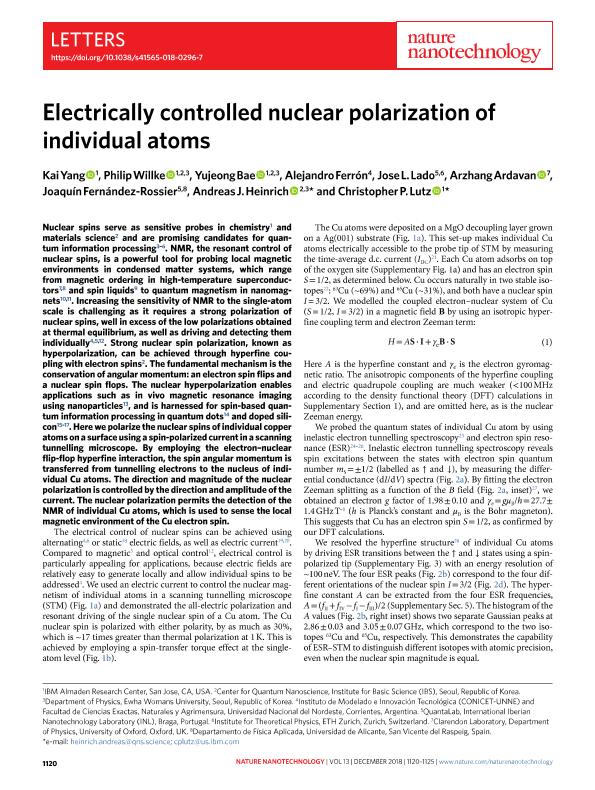Mostrar el registro sencillo del ítem
dc.contributor.author
Yang, Kai

dc.contributor.author
Willke, Philip

dc.contributor.author
Bae, Yujeong

dc.contributor.author
Ferrón, Alejandro

dc.contributor.author
Lado, Jose Luis

dc.contributor.author
Ardavan, Arzhang

dc.contributor.author
Fernandez Rossier, Joaquín

dc.contributor.author
Heinrich, Andreas

dc.contributor.author
Lutz, Christopher

dc.date.available
2019-08-07T15:30:52Z
dc.date.issued
2018-12
dc.identifier.citation
Yang, Kai; Willke, Philip; Bae, Yujeong; Ferrón, Alejandro; Lado, Jose Luis; et al.; Electrically controlled nuclear polarization of individual atoms; Nature Publishing Group; Nature Nanotechnology; 13; 12; 12-2018; 1120-1125
dc.identifier.issn
1748-3387
dc.identifier.uri
http://hdl.handle.net/11336/81075
dc.description.abstract
Nuclear spins serve as sensitive probes in chemistry1 and materials science2 and are promising candidates for quantum information processing3–6. NMR, the resonant control of nuclear spins, is a powerful tool for probing local magnetic environments in condensed matter systems, which range from magnetic ordering in high-temperature superconductors7,8 and spin liquids9 to quantum magnetism in nanomagnets10,11. Increasing the sensitivity of NMR to the single-atom scale is challenging as it requires a strong polarization of nuclear spins, well in excess of the low polarizations obtained at thermal equilibrium, as well as driving and detecting them individually4,5,12. Strong nuclear spin polarization, known as hyperpolarization, can be achieved through hyperfine coupling with electron spins2. The fundamental mechanism is the conservation of angular momentum: an electron spin flips and a nuclear spin flops. The nuclear hyperpolarization enables applications such as in vivo magnetic resonance imaging using nanoparticles13, and is harnessed for spin-based quantum information processing in quantum dots14 and doped silicon15–17. Here we polarize the nuclear spins of individual copper atoms on a surface using a spin-polarized current in a scanning tunnelling microscope. By employing the electron–nuclear flip-flop hyperfine interaction, the spin angular momentum is transferred from tunnelling electrons to the nucleus of individual Cu atoms. The direction and magnitude of the nuclear polarization is controlled by the direction and amplitude of the current. The nuclear polarization permits the detection of the NMR of individual Cu atoms, which is used to sense the local magnetic environment of the Cu electron spin.
dc.format
application/pdf
dc.language.iso
eng
dc.publisher
Nature Publishing Group

dc.rights
info:eu-repo/semantics/openAccess
dc.rights.uri
https://creativecommons.org/licenses/by-nc-sa/2.5/ar/
dc.subject
Stm
dc.subject
Hiperfine
dc.subject
Rmn
dc.subject.classification
Física de los Materiales Condensados

dc.subject.classification
Ciencias Físicas

dc.subject.classification
CIENCIAS NATURALES Y EXACTAS

dc.title
Electrically controlled nuclear polarization of individual atoms
dc.type
info:eu-repo/semantics/article
dc.type
info:ar-repo/semantics/artículo
dc.type
info:eu-repo/semantics/publishedVersion
dc.date.updated
2019-08-01T19:57:25Z
dc.identifier.eissn
1748-3395
dc.journal.volume
13
dc.journal.number
12
dc.journal.pagination
1120-1125
dc.journal.pais
Reino Unido

dc.journal.ciudad
Londres
dc.description.fil
Fil: Yang, Kai. Ibm Research; Estados Unidos
dc.description.fil
Fil: Willke, Philip. Ibm Research; Estados Unidos. Institute for Basic Science. Center for Quantum Nanoscience; Corea del Sur. Ewha Womans University; Corea del Sur
dc.description.fil
Fil: Bae, Yujeong. Ibm Research; Estados Unidos. Institute for Basic Science. Center for Quantum Nanoscience; Corea del Sur. Ewha Womans University; Corea del Sur
dc.description.fil
Fil: Ferrón, Alejandro. Consejo Nacional de Investigaciones Científicas y Técnicas. Centro Científico Tecnológico Conicet - Nordeste. Instituto de Modelado e Innovación Tecnológica. Universidad Nacional del Nordeste. Facultad de Ciencias Exactas Naturales y Agrimensura. Instituto de Modelado e Innovación Tecnológica; Argentina. Universidad Nacional del Nordeste. Facultad de Ciencias Exactas y Naturales y Agrimensura. Departamento de Física; Argentina
dc.description.fil
Fil: Lado, Jose Luis. Universitat Zurich; Suiza. International Iberian Nanotechnology Laboratory; Portugal
dc.description.fil
Fil: Ardavan, Arzhang. University of Oxford; Reino Unido
dc.description.fil
Fil: Fernandez Rossier, Joaquín. Universidad de Alicante; España. International Iberian Nanotechnology Laboratory; Portugal
dc.description.fil
Fil: Heinrich, Andreas. Institute for Basic Science. Center for Quantum Nanoscience; Corea del Sur. Ewha Womans University; Corea del Sur
dc.description.fil
Fil: Lutz, Christopher. Ibm Research; Estados Unidos
dc.journal.title
Nature Nanotechnology

dc.relation.alternativeid
info:eu-repo/semantics/altIdentifier/url/https://www.nature.com/articles/s41565-018-0296-7
dc.relation.alternativeid
info:eu-repo/semantics/altIdentifier/doi/http://dx.doi.org/10.1038/s41565-018-0296-7
Archivos asociados
